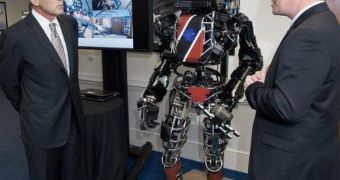Despite all the horror stories and murder-filled films involving robots, humankind continues to create and recreate robotic contraptions. Case in point, the Pentagon has just revealed the Atlas human-size robot.
After watching the Terminator film series, you're liable to see those man-killing machines in every bipedal robot ever made.
The Pentagon doesn't mind though. Or maybe it just wants to help dispel most of the fears that the public may harbor towards such things.
Anyway, scientists from the Pentagon have created a bipedal robot that looks, mostly, like a human, and is the same size as us men too (AFP).
DARPA (the Pentagon's defense research arm) is the division that made the thing, and showed the robot to US Defense Secretary Chuck Hagel.
Atlas is 6-foot-2-inch (1.87 meters) tall and is meant to conduct rescue operations, not man-murdering ones, so you can relax. For now anyway.
Atlas is one of the many robots that came to be as a result of the Fukushima nuclear meltdown that followed the earthquake and tsunami of March 16, 2011. It won't have anyone to rescue from such a radiation-rich environment at this point, but it should be able to move debris and such much more easily than normal crewmen.
And it should be deployable in rescue teams when dealing with fires or collapsed buildings too.
We'd love to walk you through all the abilities of the Atlas, but sadly that information was kept pretty much under wraps.
Even Hagel only got to look at its completely stationary, frozen-in-time form, which only has some LED lights on.
So while we do have DARPA's word that the thing can move like humans do, and lift weights that normal men can't, we have no actual proof.
There was also no exact time frame given for when the Atlas would be requisitioned by rescue crews and hazard-daring teams.
That said, there are some things we should consider here. For one thing, bipedal robots are pretty rare, because simulating locomotion and ensuring balance isn't an easy task. Because of that, most human-shaped bots have trouble walking and especially running.
Secondly, robots are, generally, pretty expensive, and bipedal ones more so due to the difficulty of actually making them life-like and capable of standing/walking on their own.
All this points towards a no doubt exorbitant price, and if Atlas really isn't meant for the military (which is known for buying lots of hardware), then there might be issues with finding buyers for the robot. Alas.

 14 DAY TRIAL //
14 DAY TRIAL //